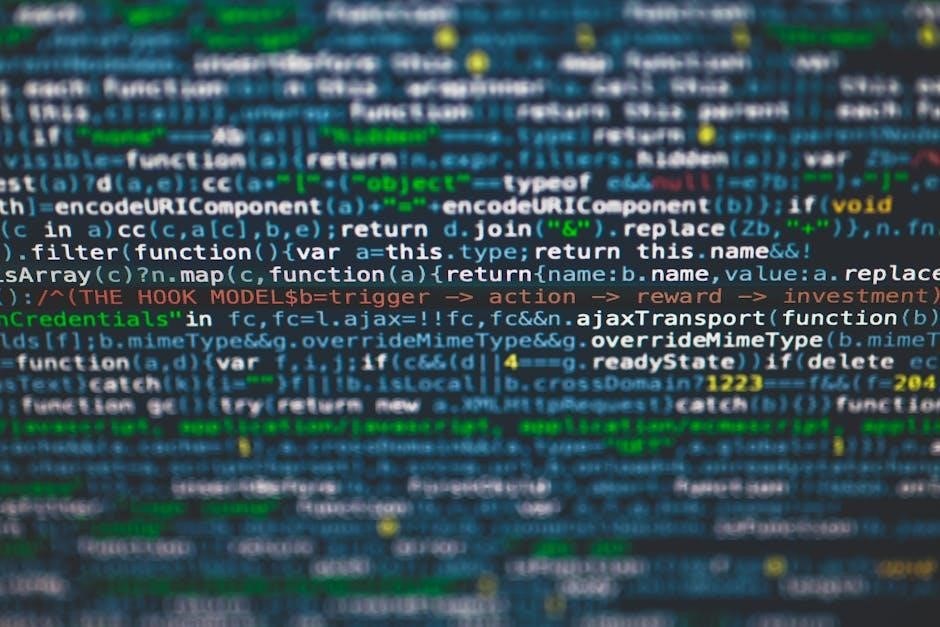The DfE Attendance Codes for 2024 aim to enhance schools’ ability to track and categorize student attendance accurately. These codes, effective from 19th August 2024, provide clear guidelines for recording absences and attendances, helping schools identify patterns and improve overall attendance management. They are designed to support schools in understanding the reasons behind pupil absences and ensure compliance with statutory requirements. The updated codes are part of the DfE’s initiative to improve attendance tracking and pupil support in the 2024/2025 academic year.
1.1 Overview of DfE Attendance Codes
The DfE Attendance Codes for 2024 are a standardized system used by schools in England to record pupil attendance and absences accurately. These codes help schools categorize reasons for absence, such as illness, authorized leave, or work experience, ensuring consistency in tracking and reporting. Introduced on 19th August 2024, the updated codes reflect changes in attendance policies and provide clearer definitions for authorized and unauthorized absences. They are designed to support schools in monitoring attendance patterns, identifying trends, and implementing strategies to improve pupil attendance. The codes are a key tool for schools to meet statutory requirements and maintain accurate records for reporting purposes.
1.2 Importance of Attendance Codes in Schools
Attendance codes are crucial for schools to accurately track and monitor pupil attendance, ensuring compliance with legal requirements. They help distinguish between authorized and unauthorized absences, providing clarity for schools, parents, and authorities. By using standardized codes, schools can identify attendance patterns, address barriers to education, and implement targeted support for pupils. These codes also facilitate effective communication with parents and guardians, ensuring everyone understands the reasons for absences. Additionally, they aid in generating precise reports for local authorities and the DfE, supporting accountability and the improvement of overall attendance outcomes. Accurate use of these codes is essential for maintaining reliable records and fostering a culture of attendance within schools.

Key Changes in DfE Attendance Codes for 2024
The 2024 DfE Attendance Codes introduce new codes such as J1, inactive codes H, Y, and J, and provide updated guidance for accurate attendance tracking from 19th August 2024.
2.1 New Attendance Codes Introduced in 2024
The DfE has introduced new attendance codes for the 2024/2025 academic year to improve tracking and clarity. One notable addition is the J1 code, which replaces the previous J code and is now categorized under Authorised Absence, reflecting its updated purpose. Additionally, the W code has been introduced specifically for pupils attending work experience arranged by the school or local authority, ensuring such activities are accurately recorded. These new codes aim to provide a more detailed and precise method of logging student attendance, helping schools to better monitor and address attendance patterns effectively from 19th August 2024 onwards.
2;2 Codes That Have Been Inactive or Replaced
Several attendance codes have been inactive or replaced for the 2024/2025 academic year. The H, Y, and J codes are no longer in use, with J being replaced by J1, now categorized under Authorised Absence. Additionally, the C code is now used for service children requiring term-time holidays, streamlining the process. Schools must ensure they no longer use archived codes for new records, although historical data remains accessible. These changes aim to enhance accuracy and compliance with DfE guidelines, effective from 19th August 2024. Understanding these updates is crucial for proper attendance tracking and reporting in the new academic year.
2.3 Updated Guidance on Attendance Code Usage
The DfE has released updated guidance on attendance code usage for the 2024/2025 academic year, effective from 19th August 2024. This guidance clarifies the proper application of new and revised codes, ensuring consistency across schools. It emphasizes distinguishing between authorised and unauthorised absences, with codes like J1 replacing previous codes to reflect attendance status accurately. Schools are advised to refer to the updated documents for detailed explanations of each code and their appropriate use. The guidance also highlights the importance of accurate recording to support pupil attendance tracking and legal compliance. Understanding these updates is essential for schools to align their practices with DfE expectations effectively.

Understanding the 2024 Attendance Codes
The 2024 Attendance Codes provide a structured framework for tracking pupil attendance, distinguishing between authorised and unauthorised absences. They offer clarity on absence reasons, ensuring accurate recording and compliance with DfE guidelines.
3.1 Explanation of New and Revised Codes
The 2024 Attendance Codes introduce several new and revised codes to better categorize pupil absences. New codes include W for work experience and J1, replacing J, now indicating authorised absences. Codes H, Y, and J are inactive. The C code is now used for service children’s term-time holidays. These changes aim to improve accuracy in tracking attendance and distinguishing authorised from unauthorised absences. Schools must update their systems to reflect these codes, ensuring compliance with DfE guidelines. The revised codes also provide clearer definitions, helping staff understand when to use each code appropriately. Accurate use of these codes supports better attendance monitoring and reporting.
3.2 Categorization of Attendance Codes
The 2024 Attendance Codes are categorised to distinguish between authorised and unauthorised absences, ensuring clarity in tracking pupil attendance. Codes are grouped into key categories, such as illness, medical appointments, and truancy, providing specific reasons for absences. New codes like W (work experience) and J1 (authorised absence) fall under specific categories, while inactive codes like H, Y, and J are phased out. This categorisation helps schools identify trends, monitor attendance patterns, and address underlying issues. Clear categorisation also aids in generating accurate reports and supports schools in meeting statutory requirements, ensuring effective attendance management and pupil support.

Implementation of the 2024 Attendance Codes
The 2024 Attendance Codes will be implemented from the 19th August 2024, requiring schools to update their systems and train staff on the new coding framework. Effective preparation ensures seamless transition, with schools communicating changes to parents and stakeholders to maintain consistency in attendance tracking.
4.1 Preparation for the New Academic Year

Schools must review their attendance systems ahead of the 2024/2025 academic year to ensure compliance with the updated DfE Attendance Codes. Key steps include familiarizing staff with new codes, such as W for work experience and J1 for authorised absences, while phasing out inactive codes like H, Y, and J. Training sessions should focus on accurate code usage to avoid errors. Schools should also update their attendance software and communicate changes to parents, ensuring a smooth transition. Clear guidance from the DfE, including the updated Working Together to Improve School Attendance document, will support schools in preparing effectively for the new codes.
4.2 Training and Support for School Staff
Effective training is crucial for school staff to understand and apply the 2024 DfE Attendance Codes accurately. Schools should organize workshops and briefings to familiarize staff with new codes, such as W for work experience and J1 for authorised absences. Emphasis should be placed on understanding replaced or inactive codes, like H, Y, and J, to avoid confusion. Staff should also learn how to use updated systems for recording attendance. The DfE provides resources, including the Working Together to Improve School Attendance guide, to support training efforts. Regular updates and access to support materials will ensure staff are confident and compliant with the new codes. This ensures accurate attendance tracking and consistent application across the school.

Impact of the 2024 Attendance Codes
The 2024 Attendance Codes enhance schools’ ability to track and categorize absences, providing clearer insights and supporting improved attendance management strategies.
5.1 Effects on School Attendance Tracking
The 2024 Attendance Codes have significantly enhanced schools’ ability to track attendance accurately. By introducing new codes such as W for work experience and replacing outdated codes like J with J1, schools can now distinguish between authorised and unauthorised absences more clearly. This improvement allows for better identification of attendance patterns, enabling schools to monitor pupil attendance more effectively. The updated codes also ensure compliance with statutory requirements, providing a consistent framework for recording absences. Additionally, the changes support schools in generating precise reports and communicating effectively with parents and local authorities, ultimately improving overall attendance management and pupil support systems.
5.2 Implications for Pupils and Parents
The 2024 Attendance Codes bring clarity for pupils and parents regarding absence recording. New codes, such as W for work experience, help pupils understand the reasons behind their absences. Parents benefit from clearer communication about authorised and unauthorised absences, enabling them to address attendance issues promptly. The updated codes also ensure pupils and parents are aware of their responsibilities, fostering better cooperation with schools. Additionally, the changes support schools in working closely with families to identify and address barriers to attendance, promoting a collaborative approach to improving pupil attendance and overall educational outcomes.

Legal and Statutory Requirements
Schools must comply with DfE attendance guidelines, ensuring accurate recording and reporting. Local authorities play a key role in enforcing these statutory requirements, maintaining legal standards.
6.1 Compliance with DfE Attendance Guidelines
Compliance with DfE attendance guidelines is mandatory for all schools in England. Schools must use the updated attendance codes from 19th August 2024 for the 2024/2025 academic year. Local authorities enforce these statutory requirements, ensuring schools adhere to legal standards. Accurate recording of attendance using the new codes is essential to maintain compliance. Schools must discontinue the use of inactive or replaced codes, such as H, Y, and J, and adopt the revised codes like J1. Failure to comply may result in legal consequences. The DfE provides guidance to support schools in meeting these requirements, ensuring consistency and fairness in attendance tracking nationwide.
6.2 Role of Local Authorities in Enforcement
Local Authorities (LAs) play a crucial role in enforcing DfE attendance guidelines. They monitor schools’ compliance with statutory attendance codes and provide support to address attendance issues. LAs are responsible for issuing penalty notices for unauthorised absences, ensuring schools adhere to legal requirements. They work closely with schools to improve attendance and address barriers to education. LAs also provide guidance on the correct use of attendance codes, helping schools navigate the updated 2024 codes. Their involvement ensures consistency in attendance tracking and supports the DfE’s goal of improving pupil attendance and engagement across England.

Best Practices for Using Attendance Codes
Schools should ensure accurate and consistent use of DfE attendance codes, providing regular staff training and maintaining clear records to support effective attendance monitoring and reporting practices.
7.1 Accurate Recording of Attendance
Accurate recording of attendance is crucial for effective monitoring and reporting. Schools must use the updated DfE attendance codes from 19th August 2024 to ensure consistency. Staff should be trained to understand the new codes, such as the introduction of W for work experience and the replacement of J with J1 for authorised absences. Regular audits and checks should be conducted to verify the accuracy of records. Clear communication with parents and pupils about the meaning of codes is essential. Accurate recording not only supports compliance with statutory requirements but also helps identify patterns of absence, enabling targeted support for pupils and improving overall attendance outcomes.
7.2 Monitoring and Reporting Attendance Data
Monitoring and reporting attendance data is essential for identifying trends and improving pupil outcomes. Schools should regularly review attendance records, using the updated DfE codes, to track patterns of absence and lateness. By analyzing data, schools can identify pupils at risk of poor attendance and provide targeted support. Reports should include comparisons with national averages and local authority benchmarks. Schools must ensure data accuracy and consistency when generating reports for governors, local authorities, or Ofsted. Regular reviews of attendance data help schools refine strategies to improve attendance and engagement. This process supports pupil well-being and academic success while ensuring compliance with statutory requirements. Effective monitoring fosters a culture of accountability and continuous improvement.
The 2024 DfE Attendance Codes introduce clarity and consistency in tracking pupil attendance, supporting schools in improving pupil outcomes and ensuring compliance with statutory requirements effectively.
8.1 Summary of Key Updates
The 2024 DfE Attendance Codes introduced significant updates to improve attendance tracking and pupil support. New codes, such as J1, were added to clarify authorised absences, while codes H, Y, and J became inactive. The W code now specifically applies to work experience, ensuring accurate recording. Schools are advised to use code C for service children’s term-time holidays. These changes aim to enhance clarity, consistency, and compliance with statutory requirements. The updated codes support schools in identifying attendance patterns and addressing barriers to education effectively, aligning with the DfE’s goal of improving pupil outcomes and streamlining attendance management processes for the 2024/2025 academic year.

8.2 Future of Attendance Management in Schools
The future of attendance management in schools is likely to focus on enhanced data-driven strategies and personalized support for pupils. The 2024 DfE Attendance Codes lay the groundwork for more precise tracking and tailored interventions. Schools may increasingly adopt digital systems to streamline attendance recording and analysis, enabling real-time monitoring and early identification of attendance issues. Additionally, there may be a greater emphasis on collaboration between schools, local authorities, and families to address underlying causes of absences. By leveraging updated codes and innovative technologies, schools can create more inclusive and supportive environments, fostering improved attendance and overall pupil well-being in the years to come.

Additional Resources
Access the official DfE Attendance Codes 2024 PDF for comprehensive guidance. Additional support materials, including user guides and code examples, are available on the DfE website and through local authorities.
9.1 Accessing the 2024 Attendance Codes PDF
The official 2024 Attendance Codes PDF is available on the DfE website, providing detailed information on new, updated, and archived codes. Schools can download this document to ensure compliance and accurate recording of attendance. The PDF includes explanations of each code, implementation guidelines, and examples to aid understanding. It is essential for schools to refer to this document to stay updated on the latest changes and ensure proper usage of attendance codes for the 2024/2025 academic year. Additional resources and support materials are also accessible through the DfE’s online portal.
9.2 Further Guidance and Support Materials
Beyond the PDF, the DfE offers comprehensive guidance and support materials to help schools implement the 2024 Attendance Codes effectively. These include training modules, webinars, and detailed documentation to assist staff in understanding and applying the codes accurately. Local authorities also provide regional support, offering workshops and resources tailored to specific school needs. Additionally, the DfE’s online portal features FAQs, case studies, and best-practice guides to address common challenges. Schools can access these materials to ensure compliance and improve attendance tracking. Regular updates and notifications are also provided to keep schools informed about any changes or additional resources available throughout the academic year.



